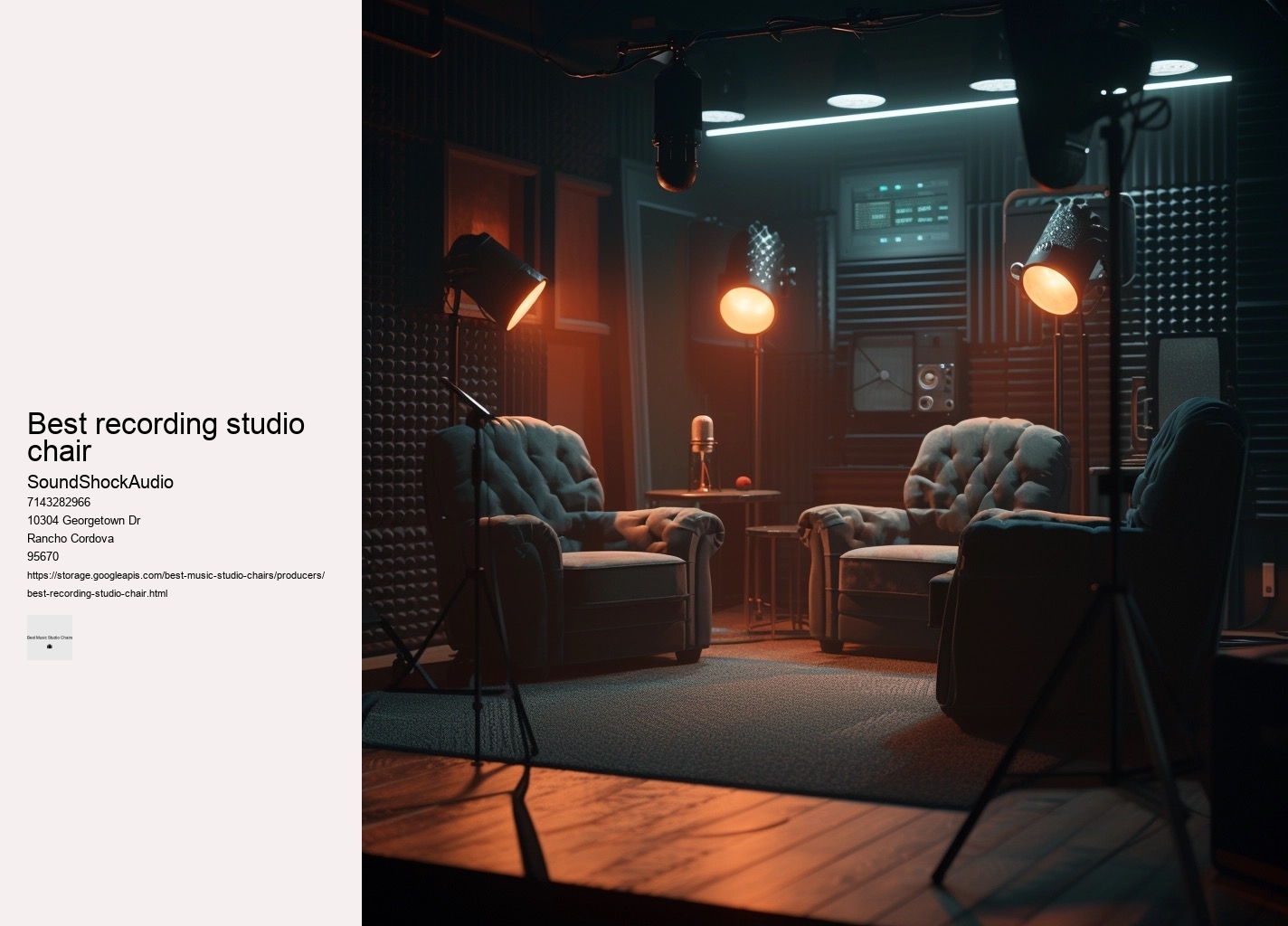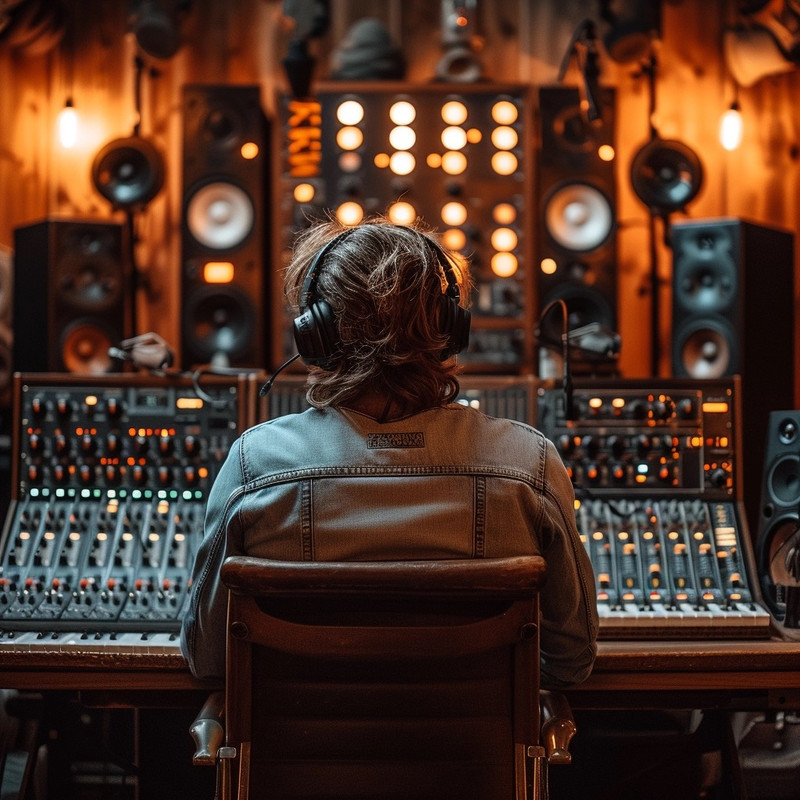

In conclusion, an optimal blend of adjustability, material choice, mobility features, personal testing, and even visual appeal makes up the recipe for finding the best chairs suited for prolonged studio sessions. Here's an unconventional guide to finding a chair that hits all the right notes. Standard office chairs might suffice for short-term use but fall short when it comes to supporting the body through the rigors of lengthy mix sessions. Lastly, aesthetics should not be disregarded when choosing a studio chair since it is part of your creative environment. Lastly, don't underestimate personal preference's role—testing different chairs until you find 'the one' is crucial since everyone's definition of comfort varies widely.
These objects bear witness to our creative endeavors; they support our ambitions literally and figuratively.
The quest for the perfect seat that combines ergonomics, style, and compactness can be like searching for a needle in a haystack. Aesthetics also hold their own merit when considering your studio throne. Certainly!
Fourthly, note the height of creativity—or rather, the height adjustment of your chair. This subtle shift in mindset can trigger a cascade of motivation and confidence that permeates through every project you tackle.
However, comfort extends beyond just physical well-being; it encompasses the mental state as well. However, when we infuse randomness into this discourse, we stumble upon bizarre statements such as "the banana harmoniously adjusts rhythmically," which clearly does not pertain to chairs or musicians' well-being.
A comfortable chair contributes positively to our focus and efficiency. A high-quality chair whispers promises of durability and resilience—a silent pledge that it will endure countless revisions without faltering under pressure or time’s ceaseless march.
While aesthetic preferences evolve rapidly within creative fields, investing in timeless craftsmanship ensures that a top studio chair remains both functional and stylish across eras.


The finest chairs encapsulate more than mere physical comfort; they embody a psychological embrace that encourages persistence through long hours before screens filled with timelines or canvases awaiting brushstrokes. Lastly but importantly is sustainability; opting for chairs made from recycled materials or from companies committed to eco-friendly practices reflects an awareness beyond one's immediate surroundings—an ethos often inherent within the artistic community. Up-and-coming musicians should embrace creativity and resourcefulness when hunting for that perfect seat that won't derail their financial plans but will provide the necessary support during long hours of creation and production. Its sturdy construction guarantees that every component from casters to armrests remains functional through countless recording sessions.
They say silence speaks volumes; here it underlines productivity free from unnecessary interruption—a testament to thoughtful design embracing virtue of stealth. Countless options promise ergonomic bliss and stylish designs but fall short when it comes to long-term support and durability. Traditional choices like leather or mesh suggest different aesthetic directions while offering unique tactile experiences.
Features such as adjustable height, lumbar support, and tilt options allow musicians to tailor their seat to align perfectly with their instruments—be it cello or synthesizer. Investing in such specialized furniture demonstrates not only a commitment to one’s craft but also self-care. The battle against fatigue in the studio can often seem like an insurmountable challenge.
A key element in maintaining focus and inspiration throughout these sessions is the chair you choose to sit in. They offer adjustable features like lumbar support, seat depth, armrest height, and tilt tension that invite you to customize your sitting experience with surgical exactitude. Users can adjust nearly every aspect of their chair so it feels less like office furniture and more like an extension of oneself—a symbiotic relationship between artist and instrument enhancing focus rather than detracting from it.
Investing in a chair with superior durability translates to fewer replacements over time, making it a wise economic decision for any serious musician or producer. Whichever camp you fall into, remember that breathability remains essential; materials like mesh allow air circulation which prevents overheating during marathon sessions. Embarking upon this journey, one might envision typical office seating—stiff backrests and unyielding armrests—yet the pinnacle of studio thrones transcends such mundane expectations.
Unlike traditional padding materials like feathers or fiberfill that compress and lose shape over time, memory foam contours to the body's shape. An ideal studio chair would offer adjustable lumbar support to accommodate this need, ensuring that long hours at the desk do not translate into back pain or more serious spinal issues.
Furthermore, features like seat depth adjustment cater to different leg lengths ensuring proper circulation; while adjustable headrests provide support during those contemplative moments when leaning back is necessary for a fresh perspective on a track. The backbone of any good studio chair is its lumbar support.
But rest assured knowing that investing time researching chairs pays dividends far greater than many initially perceive possible when embarking upon their melodic journey through endless nights bathed in dimly lit studios searching for that perfect beat—that elusive hook—that defining moment where everything clicks into place creating timeless pieces capable of touching souls across generations ad infinitum. Choosing one of these chairs means investing in yourself and your craft.

Whether for an artist's atelier, a musician's den, or a designer's workshop, each piece must serve dual purposes. Mobility within the workspace is another essential aspect. Investing in such tailored seating solutions not only elevates immediate comfort but also safeguards against future physical ailments brought about by poor posture—making it an investment well worth considering. Finally, while budget considerations may play second fiddle in this selection concerto, they cannot be ignored completely.
Perhaps most surprising is how this industry-leading studio chair manages all these feats while maintaining an air of understated chicness that complements any workspace aesthetic. Investing in a high-quality model made from robust materials will save money in the long run as it won't require frequent replacements due to wear and tear. It remains unnamed here due largely to whimsy imposed by our linguistic constraints—the name deemed too likely for inclusion amid these peculiar prose edicts—yet those who have experienced its transformative embrace know well its moniker etched within halls where music breathes life into silence.
The human body is not designed to remain static; thus, a chair that can adapt to individual ergonomic needs is essential for maintaining good posture and preventing strain or injury. Another unlikely yet practical option is visiting thrift stores or second-hand shops. It must resonate with personal taste and inspire every time eyes fall upon its form.
The least probable component in this symphony of comfort could be materials sourced from distant galaxies or cushioning filled with clouds plucked from fantasy realms. Firstly, consider the nature of movement — or rather, the lack thereof. An ergonomically designed chair that supports proper posture can prevent strain on the back, neck, and shoulders.
Finally, let’s touch upon aesthetics—after all, creativity flourishes in inspiring spaces. Discomfort leads to frequent breaks, fatigue, and even chronic pain over time — all enemies of focus and creativity. This viscoelastic substance has revolutionized seating solutions, offering a level of comfort that was once thought to be unattainable. Unveiling this paragon of comfort, we encounter a masterpiece that seamlessly integrates aesthetic appeal with practical features. In essence, although high-end microphones and state-of-the-art software play significant roles in capturing quality sound, they pale in comparison to the profound impact that good old-fashioned human care has on producing pain-free recordings.
This could make the text sound quirky or nonsensical, but here's an attempt:In a realm where melodies intertwine with technology, the unsung throne beneath the maestro often escapes limelight—yet its significance cannot be overstated. Moreover, adjustability plays a crucial role in tailoring your sitting experience to perfection. A lesser-expected trait would be incorporating sound-enhancing capabilities directly into the chair itself—perhaps built-in speakers that deliver precise audio feedback without needing headphones constantly wrapped around one's head. Spending hours on end in a studio requires a seat that offers unparalleled comfort and support to prevent fatigue and keep you focused on your craft.
The unsung hero of any studio setup is not the latest software update or the fanciest keyboard – it’s the chair we sit in for countless hours. Owners can rejoice not only in physical ease but also environmental peace of mind. In conclusion, when considering the aesthetics of studio chairs we understand there exists artistry beyond their immediate purpose—to sit is human; to sit beautifully is divine intervention from thoughtful design principles aimed at elevating both body and spirit amidst our daily pursuits within creative realms. Investing in an ergonomic chair is a statement: you value yourself and take your craft seriously enough to provide the best tools available.
When hours stretch into marathons of focused work, a reliable studio chair is not merely furniture; it transforms into a steadfast companion. It should withstand regular use without degrading in function or appearance. Finally, never underestimate aesthetic appeal – although secondary to function in this context, enjoying how a piece looks can uplift spirits subtly yet significantly each day you enter your creative sanctuary. Moreover, materials science has played its part by introducing breathable meshes and cushioning that conform more precisely to body contours while regulating temperature—eschewing the traditional foam padding which often traps heat.
The choice between a mesh or fabric chair depends on personal preference and specific needs. Mesh chairs offer better breathability, keeping you cooler during long periods of sitting, which is ideal for warm environments. Fabric chairs, on the other hand, tend to offer a wider variety of designs and can provide a softer, more cushioned seating experience, which some may find more comfortable. Ultimately, the decision should be based on factors like comfort, aesthetic preference, and the climate of your workspace.
A chair that you can sit in for 8 hours should be ergonomically designed to support your posture, reduce back strain, and enhance comfort. It typically features adjustable settings for height, armrests, lumbar support, and tilt to accommodate various body shapes and sitting preferences. Examples include high-quality office chairs from brands like Herman Miller, Steelcase, or Humanscale, which are specifically engineered for long periods of sitting while minimizing discomfort and promoting productivity.
The duration of a musical chairs game can vary depending on the number of participants and the preferences of the group playing. Typically, a game lasts between 10 to 15 minutes. It's important to adjust the length of the game to keep it engaging and fun for all players, ensuring it doesn't drag on too long or end too quickly.
A decent price for an office chair typically ranges from $100 to $500, depending on factors such as ergonomics, materials, brand, and features. Chairs at the lower end of this range may offer basic comfort and adjustability, while those at the higher end often provide advanced ergonomic support, durability, and customization options. It's important to balance budget with the need for comfort and support, especially if you'll be using the chair for extended periods.
Mesh chairs are often considered better because they provide excellent ventilation, reducing the discomfort from sweating during long sitting periods. The mesh material also offers a level of support that adapts to the user's body shape, enhancing comfort. Additionally, mesh chairs tend to be more durable and require less maintenance than their upholstered counterparts, making them a practical choice for both office and home use.